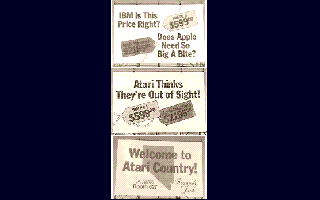--------------------------------------------------------------------------------
ATARI ST 15th Anniversary
--------------------------------------------------------------------------------

Well, it has come and nearly gone, but I didn't want the year passing by
without some formal tribute to the Atari ST range. From its debut in
January 1985 at the Comdex show in Las Vegas, Nevada, the Atari ST was a
stunning new computer system at the time.
After only owning Atari since the 2nd of July 1984, Jack Tramiel and his
team needed a next generation computer to catapult the beleaguered Atari
into the good times again. legal wrangling with his former company
Commodore, and the loss of Amiga Technologies to them as well had
certainly made the new Atari's task to design, build, test and manufacture
working models of a totally new computer system a tough challenge.
The main architect of the original Atari ST was Vice President of research
and development, Shiraz Shivji. Under his leadership, a team at Atari
designed a new computer system. Design work was started in July 1984 and
completed (including all custom I.C's) in December of the same year. Most
of the initial bug testing was complete and Atari's team based at
Sunnyvale and at the Digital Research HQ were working flat out to ensure a
fully working OS was fine tuned for the forthcoming Comdex show in January
1985, the maiden public flight of the new Atari computer.

Picture above: shows Billboards in Vegas on route to Comdex, 1985.
Courtesy of Hans-Martin Krober at the Atari and Commodore Museum
(www.best.com/~hmk/atari.htm)
The show was a success. The Atari ST was launched with much praise, and
it became one of the most popular computers in Germany during the mid-late
eighties, something a lot of American PC manufacturers have still failed
to do. In fact, Europe was Atari's most successful market, in contrast
to the U.S. market with its tougher competition, was always a strain on
Atari, its dealers and ultimately its end users.
But the ST did change the face of computing, although it gets little
recognition for that today. Atari did a lot of things right, and had its
fair share of "challenges" along the way, including a global recession,
competition especially from MS Windows, FCC problems, a late entry back
into the video game business and a lack of strong advertising and support
to its dealer network.
The Atari ST was particularly strong in the music industry, with the
inclusion of MIDI ports being one of the clever design aspects of the
machine. Atari also paved a niche into the DTP market with its low cost
laser printer and high end DTP software. Unfortunately, these were never
sustained markets for varying reasons and the ST became a "niche computer"
and a popular games machine in Europe.
The ST also suffered from a lack of continued development, the Mega ST
which followed the standard "all-in-one" product, was nothing more than a
redesigned box with the famous "blitter" graphics chip and a separate
keyboard. The STE (Enhanced) that followed 2 years later was a minor
upgrade that increased the colour palette, reduced chip count and included
stereo sound, among the more noticeable but lack-luster enhancements.
When the MegaSTE was released in 1990, it was another step forward for the
range, introducing a new case design "borrowed" from its bigger brother,
the Atari TT, it had a 16Mhz 68000 and a built-in hard drive. But this
would be the last development of the ST, a computer that served thousands
in its Seven year life-span. (Estimated world-wide installed base was
approx. 1.6 Million).
The ST brought true "Power without the price", but it didn't deliver this
to the business market. It was a popular "home" computer, although
accepted as a more respectable machine in Germany. Ultimately, the PC
would kill off these advanced machines, along with the exciting "home"
market. The battle between Commodore, Atari and Apple would result in one
winner in the dedicated non-wintel market place, and although Apple had
just scraped through, it managed to survive. Atari left the computer
market in 1993 and tried its hand at video gaming one more time...
Although it's all over, we should be thankful that the ST was developed
and released - it changed computing in the 80's, and introduced new and
exciting possibilities for the consumer. The Atari ST is a piece of
computing history, just as ground-breaking as any Apple or IBM PC of the
era and one of the many historic products of Atari Corporation.
--------------------------------------------------------------------------------
The ST was codenamed RBP in-house. It stood for "Rock Bottom Prices", and
was taken from a previous Commodore project many years earlier.
--------------------------------------------------------------------------------
|



